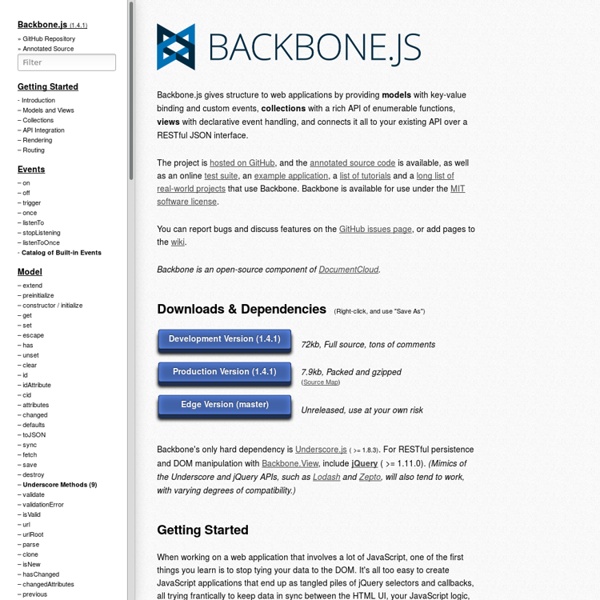Popcorn.js 0.2 Released – Popcorn.js 0.2 Released – Bocoup Web Log
I am very proud to announce that Popcorn.js hit 0.2 today. The Popcorn.js team has been working hard to deliver a stable, documented and unit tested JavaScript toolbelt for working with HTML5 <video>. Popcorn.js 0.2 rethinks Popcorn.js 0.1 as an event system for HTML5 <video> with a sexy API, a plugin system, and strong adherence to the native HTML5 <video> API. Popcorn.js’ API follows the standard HTML5 method names by using a passthrough system to the native HTMLVideoElement. Popcorn builds on these native method names like .mute(), .load() and .play(), and adds new method names like .exec(), .listen(), .trigger(), .getTrackEvents(), and so on.
Stapes.js - a (really) tiny Javascript MVC microframework
Introduction For a quick introduction to Stapes, follow the tutorial, and write a todo app in less than 100 lines of code. Write your Stapes modules like this Then, use it like this. var module = new Module('Emmylou'); module.sayName(); Examples
Welcome to Jinja2 — Jinja2 2.7-dev documentation
Jinja2 is a modern and designer friendly templating language for Python, modelled after Django’s templates. It is fast, widely used and secure with the optional sandboxed template execution environment: <title>{% block title %}{% endblock %}</title><ul>{% for user in users %} <li><a href="{{ user.url }}">{{ user.username }}</a></li>{% endfor %}</ul> Features: sandboxed executionpowerful automatic HTML escaping system for XSS preventiontemplate inheritancecompiles down to the optimal python code just in timeoptional ahead of time template compilationeasy to debug.
Organizing Your Backbonejs Application With Modules
If you have spent any time looking at Backbone.js, like many others, you are probably amazed by how lightweight, flexible and elegant it is. Backbone.js is incredibly powerful, but not prescriptive in how it should be used. With great power comes great responsibility, and if you’ve tried to use Backbone.js for a large project you might be asking yourself: how do I organize my code? When thinking about “code organization” the questions you might be asking are:
dotjs — hack the web
README.markdown ..................... dotjs ........................ dotjs is a Google Chrome extension that executes JavaScript files in ~/.js based on their filename. If you navigate to dotjs will execute ~/.js/google.com.js. This makes it super easy to spruce up your favorite pages using JavaScript. On subdomains such as dotjs will try to load ~/.js/gist.github.com.js as well as ~/.js/github.com.js and ~/.js/com.js.
soma.js
soma.js or Get to the site
iScroll
This script has been superseded by iScroll 4 . This page is kept for historical reasons . Project info Project state: ACTIVE (code is actively updated) Last code update: 2010.10.08 – v3.7.1 Device compatibility: iPhone/Ipod touch >=2.0, Android >=1.5, iPad >=3.2. Discussion Group QR Code opens demo page.
JavaScript Architecture: Backbone.js Routers
Updated Aug 11, 2012 to reflect current library versions. In JavaScript Architecture: Backbone.js Views we discussed how to build dynamic apps that change views on the fly using JavaScript. Because view-switching is done without reloading the page or transferring control to a separate page, these are called single-page applications. Single-page applications pose a few issues we need to address:
About
Paper.js — The Swiss Army Knife of Vector Graphics Scripting. Paper.js is an open source vector graphics scripting framework that runs on top of the HTML5 Canvas. It offers a clean Scene Graph / Document Object Model and a lot of powerful functionality to create and work with vector graphics and bezier curves, all neatly wrapped up in a well designed, consistent and clean programming interface. Paper.js is based on and largely compatible with Scriptographer, a scripting environment for Adobe Illustrator with an active community of scripters and more than 10 years of development. Paper.js is easy to learn for beginners and has lots to master for intermediate and advanced users. Paper.js is developed by Jürg Lehni & Jonathan Puckey, and distributed under the permissive MIT License.
Closure Tools
What is the Closure Compiler? The Closure Compiler is a tool for making JavaScript download and run faster. Instead of compiling from a source language to machine code, it compiles from JavaScript to better JavaScript. It parses your JavaScript, analyzes it, removes dead code and rewrites and minimizes what's left. It also checks syntax, variable references, and types, and warns about common JavaScript pitfalls. How can I use the Closure Compiler?


